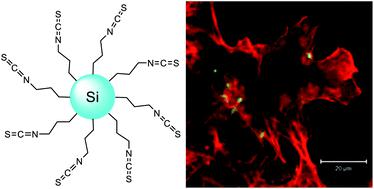当前位置:
X-MOL 学术
›
Faraday Discuss.
›
论文详情
Our official English website, www.x-mol.net, welcomes your feedback! (Note: you will need to create a separate account there.)
Synthesis and characterisation of isothiocyanate functionalised silicon nanoparticles and their uptake in cultured colonic cells.
Faraday Discussions ( IF 3.4 ) Pub Date : 2020-01-14 , DOI: 10.1039/c9fd00087a Yimin Chao 1 , Ashley I Marsh , Mehrnaz Behray , Feng Guan , Anders Engdahl , Yueyang Chao , Qi Wang , Yongping Bao
Faraday Discussions ( IF 3.4 ) Pub Date : 2020-01-14 , DOI: 10.1039/c9fd00087a Yimin Chao 1 , Ashley I Marsh , Mehrnaz Behray , Feng Guan , Anders Engdahl , Yueyang Chao , Qi Wang , Yongping Bao
Affiliation

|
The functionalisation of silicon nanoparticles with a terminal thiocyanate group, producing isothiocyanate-capped silicon nanoparticles (ITC-capped SiNPs) has been successfully attained. The procedure for the synthesis is a two-step process that occurs via thermally induced hydrosilylation of hydrogen terminated silicon nanoparticles (H-SiNPs) and further reaction with potassium thiocyanate (KSCN). The synthesis was confirmed by Fourier transform infrared (FTIR) spectroscopy and X-Ray photoelectron spectroscopy (XPS). At the same time, the internalisation and the cytotoxicity of the ITC-capped SiNPs in vitro were assessed in two cell lines: Caco-2, human colorectal cancer cells and CCD-841, human colon “normal” cells. The results showed that above concentrations of 15 µg ml−1, the cell viability of both cell lines was depleted significantly when treated with ITC SiNPs, particularly over a 48 hour period, to approximately 20% cell viability at the highest treatment concentration (70 µg ml−1). Flow cytometry was employed to determine cellular uptake in Caco-2 cells treated with ITC SiNPs. It was observed that at lower SiNP concentrations, uptake efficiency was significantly improved for time periods under 12 hours; overall it was noted that cellular uptake was positively dependent on the period of incubation and the temperature of incubation. As such, it was concluded that the mechanism of uptake of ITC SiNPs was through endocytosis. Synchrotron FTIR spectroscopy, by means of line spectral analysis and IR imaging, provided further evidence to suggest the internalisation of ITC SiNPs displays a strong localisation, with an affinity for the nucleus of treated Caco-2 cells.
中文翻译:

异硫氰酸酯官能化的硅纳米颗粒的合成,表征及其在结肠细胞中的摄取。
已经成功地实现了具有末端硫氰酸酯基团的硅纳米颗粒的功能化,从而生产了异硫氰酸酯封端的硅纳米颗粒(ITC封端的SiNP)。合成过程是一个两步过程,该过程通过热诱导氢封端的硅纳米粒子(H-SiNPs)进行氢化硅烷化并与硫氰酸钾(KSCN)进一步反应而发生。通过傅里叶变换红外(FTIR)光谱和X射线光电子能谱(XPS)证实了合成。同时,在两种细胞系中评估了ITC封端的SiNP的体外内在化和细胞毒性:Caco-2,人结肠直肠癌细胞和CCD-841,人结肠“正常”细胞。结果表明,以上浓度为15 µg ml-1,当用ITC SiNPs处理时,两个细胞系的细胞生存力都显着减少,尤其是在48小时内,在最高处理浓度(70 µg ml -1)。流式细胞仪用于确定ITC SiNPs处理的Caco-2细胞的细胞摄取。观察到,在较低的SiNP浓度下,在12小时以下的时间段内,吸收效率显着提高。总的来说,注意到细胞摄取与孵育时间和孵育温度成正比。因此,可以得出结论,ITC SiNPs的摄取机制是通过内吞作用。同步线FTIR光谱通过线谱分析和IR成像提供了进一步的证据,表明ITC SiNPs的内在化表现出很强的定位性,并且对处理过的Caco-2细胞核具有亲和力。
更新日期:2020-01-14
中文翻译:

异硫氰酸酯官能化的硅纳米颗粒的合成,表征及其在结肠细胞中的摄取。
已经成功地实现了具有末端硫氰酸酯基团的硅纳米颗粒的功能化,从而生产了异硫氰酸酯封端的硅纳米颗粒(ITC封端的SiNP)。合成过程是一个两步过程,该过程通过热诱导氢封端的硅纳米粒子(H-SiNPs)进行氢化硅烷化并与硫氰酸钾(KSCN)进一步反应而发生。通过傅里叶变换红外(FTIR)光谱和X射线光电子能谱(XPS)证实了合成。同时,在两种细胞系中评估了ITC封端的SiNP的体外内在化和细胞毒性:Caco-2,人结肠直肠癌细胞和CCD-841,人结肠“正常”细胞。结果表明,以上浓度为15 µg ml-1,当用ITC SiNPs处理时,两个细胞系的细胞生存力都显着减少,尤其是在48小时内,在最高处理浓度(70 µg ml -1)。流式细胞仪用于确定ITC SiNPs处理的Caco-2细胞的细胞摄取。观察到,在较低的SiNP浓度下,在12小时以下的时间段内,吸收效率显着提高。总的来说,注意到细胞摄取与孵育时间和孵育温度成正比。因此,可以得出结论,ITC SiNPs的摄取机制是通过内吞作用。同步线FTIR光谱通过线谱分析和IR成像提供了进一步的证据,表明ITC SiNPs的内在化表现出很强的定位性,并且对处理过的Caco-2细胞核具有亲和力。


























 京公网安备 11010802027423号
京公网安备 11010802027423号